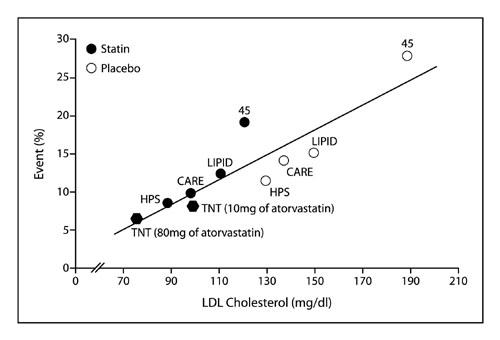GEM - lipid lowering treatment educational module part two - the evidence base
Lipid Lowering - The Evidence Base
This GEM identifies some of the important lipid lowering trials. Lipid lowering is now firmly established as a treatment intervention employed mainly in primary care and therefore it is useful for primary care care clinicians to be aware of the basis for the treatment strategies used. The simplest way to impart this information is to highlight the most significant trials and for the for the reader to explore the GPnotebook (GPN) reference to find out more information.
The use of statins as a measure to reduce risk of cardiovascular disease has been well-established since the 1990s.
- statins in patients with a history of cardiovascular disease (some significant secondary prevention trials)
- 4S trial
- investigating the use of statins in a patient population with moderate hypercholesterolaemia and symptomatic coronary heart disease
- what was the dose of simvastatin used by the majority of patients in the study?
- treating 100 patients for 6 years resulted in what sort of predicted reduction in mortality compared to treatment with placebo?
- GPN reference click here
- CARE trial
- trial involving the use of pravastatin 40 mg per day
- pravastatin reduced mean plasma cholesterol concentration by 20%
- risk of either death from CHD or non-fatal myocardial infarction was reduced by 24% in the pravastatin group
- GPN reference click here
- GREACE study
- target reduction of LDL < 2.6 mmol/l
- atorvastatin versus usual care
- GPN reference click here
- LIPID
- use of pravastatin
- showed a reduction in risk of stroke
- treating 100 patients for 6.1 years resulted in a reduction in how many deaths?
- GPN reference click here
- 4S trial
- primary prevention of cardiovascular disease
- WOSCOPS
- which statin was used in this study?
- on entry the a mean cholesterol was 7.0 +/- 0.6 mmol
- treating 1000 patients for 5 years resulted in a reduction of how many deaths?
- GPN reference click here
- WOSCOPS
- a study involving primary and secondary prevention
- British Heart Protection study
- what statin and at what dose was used in this study?
- treatment for 5 years prevents myocardial infarctions, strokes or other major vascular events in 100/1000 people who have previously had a myocardial infarction
- this study also provided evidence for the benefit of treating patients with a history of diabetes or previous stroke
- GPN reference click here
- British Heart Protection study
- prevention of cardiovascular disease in particular risk groups
- diabetic patients
- evidence for the reduction in risk of cardiovascular events was revealed by the CARDS study
- what age group was examined in this study?
- the cohort investigated also had one other risk factor for cardiovascular disease
- what statin was used in this study?
- GPN reference click here
- the HPS study also showed benefit in this treatment cohort
- what age group was stated at the entry for this study?
- GPN reference click here
- given that these are the two most significant studies providing evidence for statin use in diabetics, examine the JBS2 criteria for treatment of diabetics (GPN reference click here)
- evidence for the reduction in risk of cardiovascular events was revealed by the CARDS study
- the elderly
- evidence provided by HPS and PROSPER (GPN reference click here)
- the oldest patient on entry to PROSPER was 82 years old
- cerebrovascular disease
- evidence was provided by the HPS (GPN reference click here) concerning benefit for use of statin treatment in this cohort
- in HPS, patients with a history of cerebrovascular disease on statin treatment did not show a significant relative reduction in stroke risk compared to placebo but instead showed a reduction of risk in other cardiovascular disease e.g. myocardial infarction
- diabetic patients
- some other interesting statin studies
- TNT
- compared aggressive statin treatment (atorvastatin 80 mg/d) versus atorvastatin 10mg per day
- atorvastatin 80 mg per day showed significant reduction in cardiovascular mortality
- overall though, mortality was not significantly reduced between the two treatment arms (there had been an increase in non-cardiovascular mortality in the atorvastatin 80mg per day arm)
- GPN reference click here
- REVERSAL
- high dose statin treatment was associated with halting of progression of atherosclerosis
- GPN reference click here
- ASTEROID
- high dose statin treatment was associated with reversal of atherosclerotic process
- GPN reference click here
- IDEAL
- TNT
- other treatment modalities
- fibrate studies
- VA-HIT
- showed a reduction in morbidity but not mortality
- GPN reference click here
- FIELD study
- examining use of fibrates in diabetics
- during the study a significant number of patients were started on a statin when the study design had been based on use of a fibrate only
- GPN reference click here
- VA-HIT
- nicotinic acid
- ARBITER II
- showed a slowing of progression of atherosclerosis
- GPN reference click here
- ARBITER II
- fish oils
- evidence for the use of fish oils in patients with cardiovascular disease
- GPN reference click here
- fibrate studies
- and finally...
- what does the Cholesterol Treatment Trialists' Collaborators meta-analysis 2005 show
Summary of Effect of LDL lowering on Cardiovascular Risk

Other useful reference:
Related pages
Create an account to add page annotations
Annotations allow you to add information to this page that would be handy to have on hand during a consultation. E.g. a website or number. This information will always show when you visit this page.